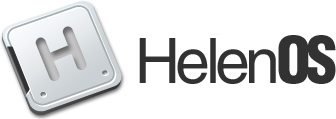Disks and File systems
File system types
HelenOS currently supports the following file systems:
| File system | /srv executable | Can be initrd FS | Has mk*fs utility | Status |
| TMPFS | tmpfs | yes | no | Stable |
| FAT | fat | yes | yes | Stable |
| locfs | locfs | no | no | Stable |
| Ext2fs/Ext3fs/Ext4fs | ext4fs | yes | yes(ext2) | Stable |
| exFAT | exfat | no | yes | Testing |
| CDFS | cdfs | no | no | Testing |
| MFS | mfs | no | yes | Stable |
| UDF | udf | no | no | Read-only testing |
HelenOS also supports the MBR/BIOS and GPT/UEFI partitioning schemes.
Directory structure
The file system of a running HelenOS system is roughly laid out as follows:
| /app | end-user applications (see the Command Reference) |
| /cfg | system-wide configuration |
| /data | application data (e.g. the web root served by websrv) |
| /drv | device drivers |
| /inc | header files |
| /lib | libraries |
| /loc | location service nodes (rough analogy of /dev in UNIX) |
| /src | source files |
| /srv | server applications (services, e.g. console, networking - see the Command Reference) |
| /tmp | temporary files |
| /w | writable system volume (has free space, can be persistent) |
This layout is not fixed in any way and may change in the future.
Block device drivers
Non-DDF:
| file_bd | File-backed block device |
| rd | Initial ramdisk |
| sata_bd | AHCI SATA |
| vbd | Virtual Block Device - provides block devices for individual partitions |
DDF-based:
| ata_bd | ATA/ATAPI |
| usbmast | USB mass storage |
| ddisk | msim disk driver |
Managing disk labels and file systems
You can use the interactive fdisk utility to create and manage disk labels.
BIOS/MBR and UEFI/GPT labels are supported. When you create a partition with fdisk,
you are also prompted for file system type (The file system will be initialized as part of
creating the partition).
If you'd like to create a file system on a raw disk, you need to do it by manually
invoking a mk*fs utility.
Here's an example fdisk session where we create a new partition table, create one partition with and Ext4 file system labeled 'Test' that will be automatically mounted at /vol/Test. Note that in several cases we just hit enter and go with the default choice.
/ # fdisk
Select device 1: devices/\hw\sys\00:01.0\ata-c1\d0 (2.097 MB) 2: devices/\hw\sys\00:01.0\ata-c2\d0 (34.09 MB) 3: Exit
Choice> 1
Device: devices/\hw\sys\00:01.0\ata-c1\d0 (2.097 MB) Disk contains no label. Entire disk: (No name) 2.097 MB, Empty Select action 1: Create label 2: Exit
Choice> 1
Select label type 1: MBR [default] 2: GPT
Choice> 1
Device: devices/\hw\sys\00:01.0\ata-c1\d0 (2.097 MB) Label type: MBR Maximum free primary block: 2.085 MB Total free primary space: 2.085 MB Select action 1: Create primary partition 2: Create extended partition 3: Delete label 4: Exit
Choice> 1
Enter capacity of new partition. ?> 2.085 MB Select file system type 1: ExFAT 2: FAT 3: MINIX 4: Ext4 [default]
Choice> 4
Enter volume label for new partition.
?> Test
Enter mount point for new partition (Auto, None or /path). ?> Auto
Device: devices/\hw\sys\00:01.0\ata-c1\d0 (2.097 MB) Label type: MBR Partition 1: Test 2.085 MB, Primary, Ext4 Select action 1: Modify partition 2: Delete partition 3: Delete label 4: Exit
Choice> 4
/ # vol Volume Name Resource Content Auto Mounted at =========== =================================== ======== ==== =============== HelenOS-CD devices/\hw\sys\00:01.0\ata-c2\d0p0 ISO 9660 Yes /vol/HelenOS-CD Test devices/\hw\sys\00:01.0\ata-c1\d0p1 Ext4 Yes /vol/Test / #
Accessing File Systems
In many cases the OS makes file systems available automatically. For any file system that has a volume label and is not located on the internal ATA disk drive, it should be automatically available under /vol/<volume_label>. This works for CD-ROMS and USB flash sticks, for example.
To find out which volumes are present in the system and where they are mounted, use the vol command. For example:
/ # vol
Volume Name Resource Content Auto Mounted at
=========== =================================== ======== ==== ===============
devices/\hw\sys\00:01.0\ata-c1\d0p0 FAT
HelenOS-CD devices/\hw\sys\00:01.0\ata-c2\d0p0 ISO 9660 Yes /vol/HelenOS-CD
#
The partition on the internal drive is not mounted by default, but we can change that using the fdisk command.
If you would like to remove a volume from the system, use the vol eject command:
# vol eject /vol/HelenOS-CD
To insert the volume back we can use either:
# vol insert -p /vol/HelenOS-CD
or
# vol insert devices/\hw\sys\00:01.0\ata-c2\d0p0
Mounting file systems manually
This should only be needed in special circumstances. In most cases use fdisk to configure the mount point. Only do this if you know what you are doing as it may break the system's idea of file system status.
Typing just mount<enter> prints out a list of mounted
file systems. The basic syntax to mount a file system is:
# mount <fstype> <directory> <service-name>
fstype is the type of the file system (e.g. fat, ext4, mfs), service-name is
the service name of the block device (typically of a partition; it's the long name like devices/\hw\pci...\l0p1) and directory is the directory path
to mount on top of.
As service-name is long to type, try cd to /loc and then use tab-completion…
You can find the list of available partition block devices in your system by typing:
# loc show-cat partition
Unlabeled disks will be represented by one 'fake' partition spanning the entire disk.
